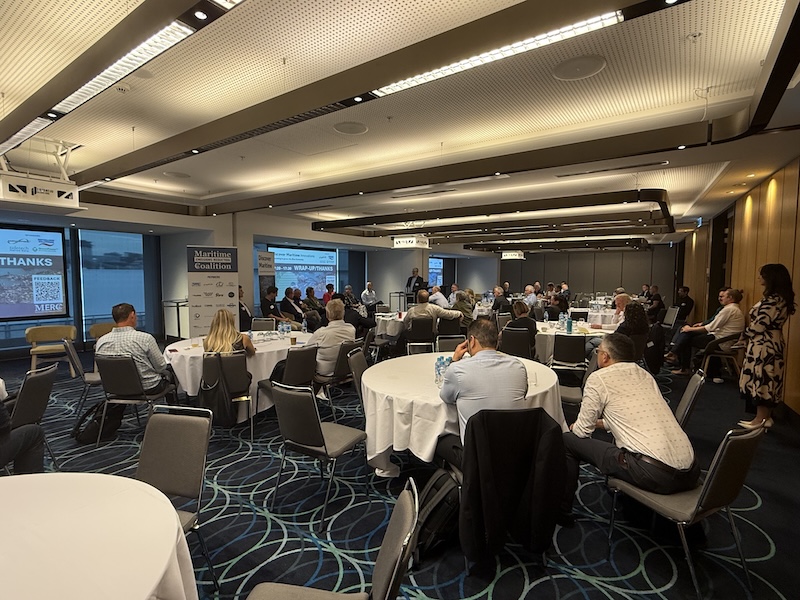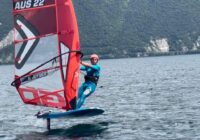One month on from the Discover Maritime Innovations 2025 (DMI2025) conference, the dust has well and truly settled. The frantic note-taking, the energetic hallway conversations, the crowded plenary sessions and the buzz of possibility have faded into memory. Yet, with the benefit of time and reflection, what remains is something deeper and far more significant: a clear sense that Australia’s maritime sector has crossed a threshold.

MERC Chair Angus McDonald
DMI2025, hosted by MERC and supported by a full house of delegates at the Hyatt Regency Sydney, was not just a showcase of new technologies. It was a snapshot of a sector with an emerging shared conviction, that the next decade of maritime operations will be defined by electrification, autonomy, digital intelligence, renewable fuel alternatives, and a far more collaborative and innovative mindset than the industry has displayed in generations.
What made the day so powerful was not simply the ideas, but the people behind them.
The room was filled not with passive observers but with practitioners, engineers, shipbuilders, operators, technologists, academics and innovators, most of whom are directly involved in building the solutions they spoke about. This was not a conference of “what ifs”, but of “what’s next, and how soon?”
Setting the Tone: A Keynote Rooted in the Past, Focused on the Future
MERC Chair Angus McDonald opened the day with a keynote that traced the lineage of maritime innovation, from industrial pioneers such as R.G. LeTourneau to Australian trailblazers like Incat Tasmania, whose radical thinking redefined fast-ferry construction. He also highlighted the international leadership of Maritime CleanTech, showing that successful clusters emerge when industry, technology developers and policy align with collective purpose.
His message landed clearly: innovation is not a destination but a culture, and history shows that the maritime sector advances when bold thinkers challenge prevailing norms. McDonald’s keynote did more than set the scene, it set the standard for what followed.
 Electrification: Technically Ready and Commercially Viable
Electrification: Technically Ready and Commercially Viable
The morning’s first Innovation Talk, delivered by Michael Eaglen of EV Maritime, was widely agreed by delegates as very valuable. His global overview of ferry electrification showcased both the opportunities and the realities of deploying battery-electric vessels at fleet scale. The recent introduction of the EVM200 platform for Auckland Transport stands as a proof point that electrification is not a future ambition but an operational reality.
That momentum was reinforced by Ampcontrol’s detailed presentation on the electrification ecosystem, hybrid powertrains, MW-scale charging, battery systems, and modular power infrastructure capable of supporting vessels across multiple duty cycles. Their demonstration of a 600 kW hybrid workboat platform and ruggedised charging systems John Welsh from Ampcontrol showed how system-level thinking is now replacing piecemeal experimentation.
Collectively, these talks made one thing abundantly clear: the technical barriers to electrification are falling quickly. What remains is the challenge of scaling infrastructure and accelerating adoption, an issue addressed powerfully in later sessions.
New Pathways for Decarbonisation: Renewable Fuels as Immediate Solutions
Electrification may dominate future long-term strategies, but the maritime industry also needs technologies that decarbonise fleets now, particularly for vessels where electrification is not yet feasible.
Refuelling Solutions’ presentation by Cliff Kemmett delivered one of the day’s most pragmatic insights: renewable diesel, biodiesel and other low-carbon liquid fuels can deliver significant emissions cuts today, without vessel modification.
Their explanation of fuel standards, quality control, and the performance of HVO100 provided important nuance. It reminded the sector that decarbonisation will not be a single technological path but a portfolio of solutions, each appropriate to specific vessels, missions and operational constraints.
Manufacturing the Future: Large-Format 3D Printing Comes of Age
One of the most striking presentations came from Hyperion’s Joshua Wigley, who addressed a topic both confronting and inspiring: the decline of Australia’s small-vessel manufacturing capability. With the median age of marine trades rising, a shrinking workforce, and increasing offshore dependence, the sector faces structural challenges.
Hyperion’s response is bold, Large-Format Additive Manufacturing (LFAM). Their containerised D3PLOY micro-factories can 3D-print hulls, components and tooling at scale, in days rather than months. Case studies of printed hulls, subsea components and docking cradles underscored the disruptive potential of this technology for defence, commercial and recreational vessels alike.
What resonated most was the way Hyperion framed the opportunity: not just as a method of producing boats, but as a pathway to rebuilding sovereign capability. With the ability to print complex large components locally, using recycled marine polymers from decommissioned offshore assets, the future of boatbuilding may well be both circular and decentralised.
Data, AI and Autonomy: The New Operating System of Maritime Work
The digital transformation of maritime operations was another defining theme.
Tidetech and DeepSea demonstrated how route planning and AI-driven vessel optimisation can deliver major efficiencies. Their examples showed tangible fuel savings, such as 8,000–10,000 kg of CO₂e saved on short-sea voyages by optimising departure time, and significant gains from tidal-aware routing in constrained waters. DeepSea’s vessel-specific AI modelling underscored a critical point: generic optimisation tools are no longer enough.
The future lies in dynamic, vessel-tailored models that continuously learn and improve.
Autonomy was brought vividly to life by Greenroom Robotics. Zac Pullen’s presentation on their 12-metre optionally crewed survey vessel, capable of 10-day endurance, cross-country transport, and uncrewed Southern Ocean missions, demonstrated the scale of transformation already underway. The vessel’s 42-day trial, covering 7,397 nautical miles with an 80% emissions reduction compared to a conventional crewed vessel, is one of the most compelling autonomy case studies to emerge from Australia.
These technologies are not fringe experiments. They are operational tools reshaping how vessels are crewed, fuelled, routed and managed.
Nature-Inspired Innovation: Tackling Biofouling with Air Lubrication
GILLS Australia presented one of the most intriguing innovations, an air lubrication and turbulence-modulation system inspired by the drag-reducing bubble trails of emperor penguins. Their unique hydrofoil system generates microbubbles that reduce hull friction and suppress biofouling.
With IMO regulations tightening (including MEPC 83), solutions like GILLS will play an increasingly critical role in vessel efficiency and environmental compliance. Their dual focus on large commercial vessels and the fast-growing small-craft market positions them well to take advantage of global demand.
Electric Boats for the Pacific and Beyond
NAUT’s Fiona Bycroft provided an excellent counterpart to the ferry-scale electrification discussed earlier, showing the breadth of applications for clean propulsion technologies. From electric ferries in Wellington to outboard retrofits, purpose-built electric vessels, and the first electric ferries for Samoa, NAUT’s work demonstrates how electrification can scale across research, tourism, commercial and recreational markets. Her session highlighted a recurring theme of the day: technology is ready, what’s needed now is acceleration.
Workforce and Supply Chain Resilience
Lynelle Johnson’s presentation on rethinking marine trades brought the human dimension into sharp focus, something that EClass Outboards is seeking to address. Workforce renewal, training pathways, supply chain fragility and the changing nature of marine service work all emerged as pressing issues. The message was clear: technological innovation must be matched by investment in people.
A Panel That Peered into the Future
The day concluded with an impromptu wrap-up panel comprising many of the Innovation Talk speakers. Their insights ranged from cautious optimism to bold predictions.

In the next 12 months, the big shifts anticipated were:
- more electric workboats entering service,
- wider adoption of digital optimisation tools,
- pilot deployments of autonomy,
- broader acceptance of renewable diesel, and
- early commercial applications of air-lubrication systems.
Looking 10 years ahead, the panel envisaged:
- mature, scalable charging networks,
- widespread vessel autonomy,
- sovereign additive manufacturing capability,
- significant emissions reductions across fleets, and
- deeper integration between digital and operational systems.
It was a fitting end to a day that was less about showcasing technology and more about aligning a sector around what comes next.
What I didn’t say was just as important.
The conference moved at an incredible pace, dynamic, dense and relentlessly engaging. If your attention drifted for even a moment, you risked losing the thread. And while this report highlights several of the key speakers, there were many more presenters whose insights added depth and perspective to the day.
For someone like me, very much a guest among an assembly of exceptional minds, it was a lot to take in. But that’s precisely what made it so valuable.
The takeaway?
Make sure you keep an eye out for the next conference and secure your seat early. It’s an opportunity you won’t want to miss.
Final Reflections
After a month of considering what I witnessed at DMI2025, one conclusion stands out: this conference was a mirror held up to our industry—not showing what it is, but what it is becoming.
A sector that once moved cautiously is now moving with purpose.
A sector that once waited for direction is now charting its own course.
A sector that once fragmented is now collaborating.
MERC deserves enormous credit for convening such a forward-thinking program, and the sponsors, Ampcontrol, Refuelling Solutions, Tidetech and GreenPower—played an essential role in enabling a day of genuine insight and practical value.
For Marine Business News, it was a privilege to be the media partner for DMI2025. More importantly, it will be our privilege to follow the journey that began in that standing-room-only ballroom, a journey that promises to redefine maritime operations in Australia and inspire many beyond our shores.








